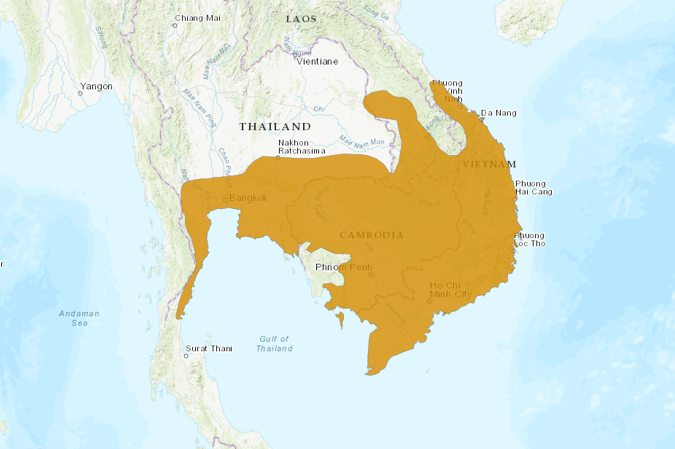Birdfinding.info ⇒ Uncommon and local but apparently increasing and expanding, especially in Thailand. In Bangkok, it can often be found reliably at Sri Nakhon Khuean Khan Park in Bang Kachao. Other consistent sites in central Thailand include Bang Phra, Chumpon, and Song Phi Nong. On Taiwan, the most consistent site has been Weiwuying Metropolitan Park in Kaohsiung City. In Israel, the introduced population is centered in Tel Aviv; Yarkon Park is a reliable site.
Vinous-breasted Starling
Acridotheres leucocephalus
Southeast Asia, where it occurs in open and semiopen habitats, including grassy scrub and agricultural fields.
Southern Indochina north to southern Laos and central Vietnam, and west to central Thailand (northwest to Tak) and the northern Malay Peninsula (south to Phuket).
An introduced population appears to be well-established and expanding around Tel Aviv, Israel, and another one appears more tenuously established in the western coastal lowlands of Taiwan.
Identification
A medium-large starling with a whitish hood, dark-gray back and wings, pale rump, wine-stained breast, yellow-orange bill and legs, and a “bandit mask” of bare blackish skin.

Vinous-breasted Starling. (Sri Nakhon Khuean Khan Park, Bang Kachao, Samut Prakan, Thailand; April 6, 2015.) © B.C. Heng

Vinous-breasted Starling. (Tambon Thong Chai, Chang Wat Prachuap Khiri Khan, Thailand; February 6, 2020.) © Edward McKen

Vinous-breasted Starlings. (Sam Ngao, Tak, Thailand; April 29, 2020.) © Gerald Moore
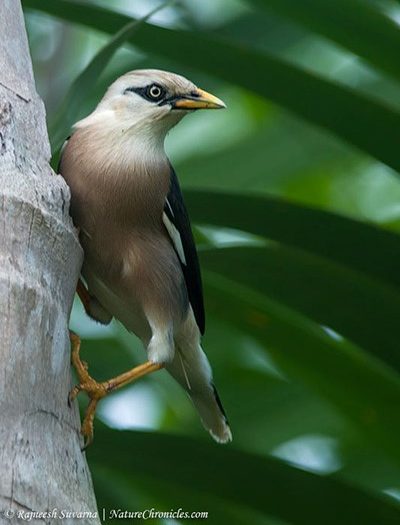
Vinous-breasted Starling. (Chumphon, Thailand; November 1, 2012.) © Rajneesh Suvarna
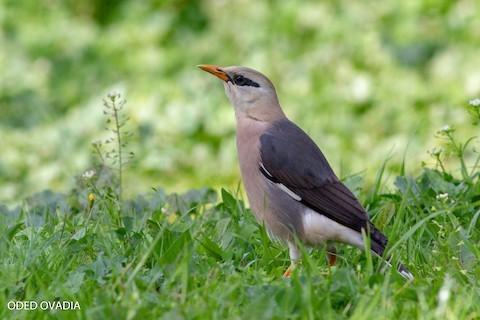
Vinous-breasted Starling. (Park HaYarkon, Tel Aviv, Israel; February 24, 2019.) © Oded Ovadia
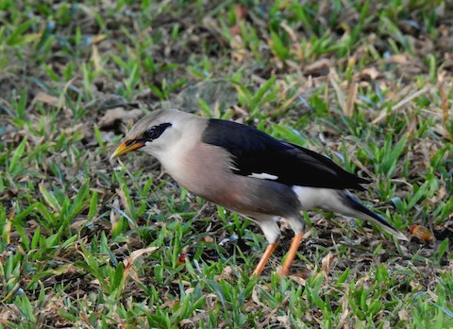
Vinous-breasted Starling. (Saphli, Chumphon, Thailand; January 26, 2020.) © John Sandve
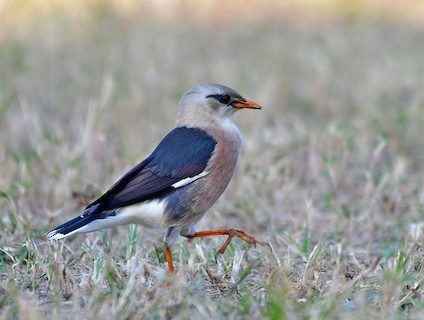
Vinous-breasted Starling. (Weiwuying Metropolitan Park, Kaohsiung City, Taiwan; February 10, 2019.) Anonymous eBirder
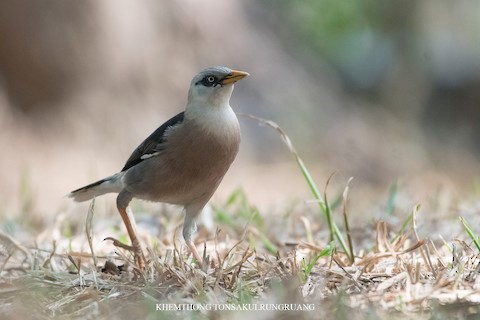
Vinous-breasted Starling. (Sri Nakhon Khuean Khan Park, Bang Kachao, Samut Prakan, Thailand; March 23, 2019.) © Khemthong Tonsakulrungruang

Vinous-breasted Starling. (Thung Wua Laen Beach, Chumphon, Thailand; November 5, 2018.) © Paul Fenwick
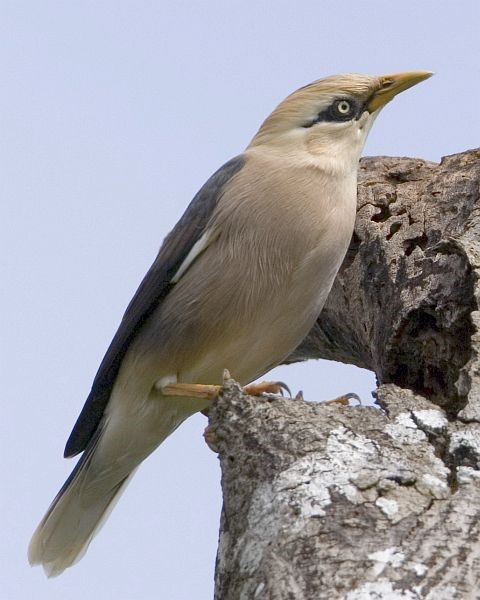
Vinous-breasted Starling, showing mostly pale underparts. (Chumphon, Thailand; October 5, 2007.) © Mike Gillam
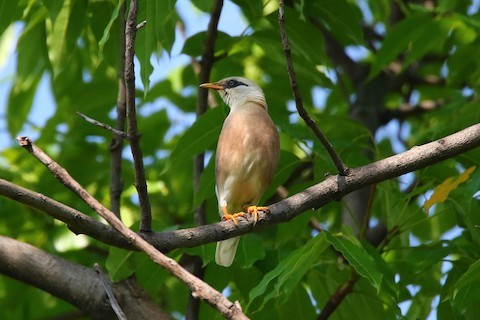
Vinous-breasted Starling. (Weiwuying Metropolitan Park, Kaohsiung City, Taiwan; June 17, 2016.) © Roland Lo

Vinous-breasted Starling with an apparently atypical head pattern, lacking white hood. (Gan-Habanim, Tel Aviv, Israel; February 15, 2020.) © Yoav Perlman
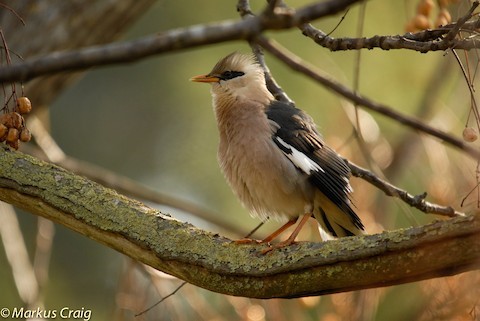
Vinous-breasted Starling. (Park HaYarkon, Tel Aviv, Israel; January 5, 2009.) © Markus Craig

Vinous-breasted Starling, showing white on wings and tail. (Weiwuying Metropolitan Park, Kaohsiung City, Taiwan; February 9, 2020.) © 志民 蘇
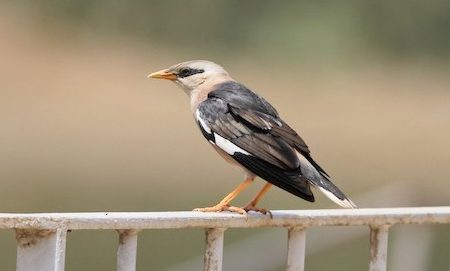
Vinous-breasted Starling, showing white on wings and tail. (Park HaYarkon, Tel Aviv, Israel; January 22, 2018.) © Ohad Sherer
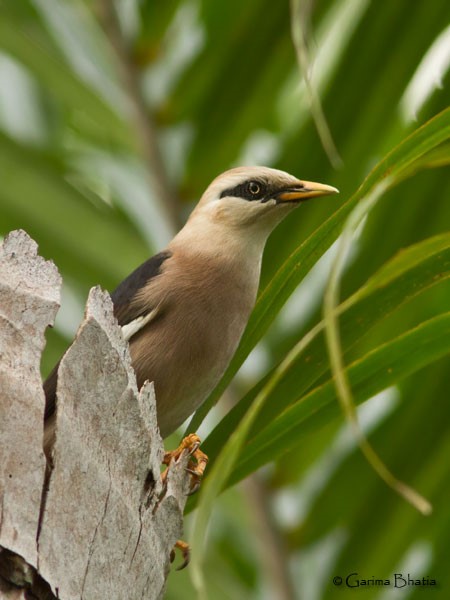
Vinous-breasted Starling. (Chumphon, Thailand; November 1, 2012.) © Garima Bhatia
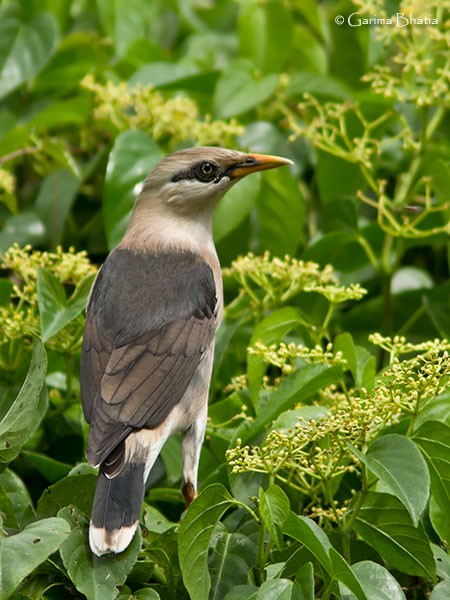
Vinous-breasted Starling. (Chumphon, Thailand; November 1, 2012.) © Garima Bhatia
Rump and tail pattern are distinctive, especially in flight: the rump is pale and the tail is black with a broad white border. In flight, also shows distinctively triangular white patches on the bases of the primaries at the leading edge of the wing.
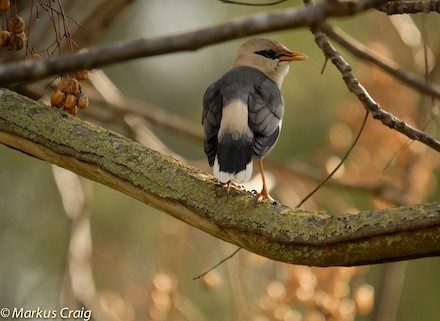
Vinous-breasted Starling, dorsal view showing pale rump and broad white tail band. (Park HaYarkon, Tel Aviv, Israel; January 5, 2009.) © Markus Craig
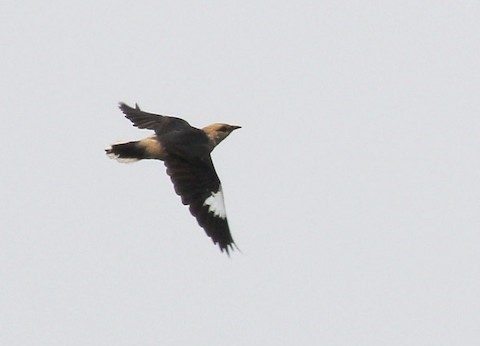
Vinous-breasted Starling, in flight, showing pale rump, broad white tail band, and shape and position of white wing-patches. (Chua Binh Son, Binh Thuan, Vietnam; October 23, 2015.) © Andrey Vlasenko
Cf. Burmese Starling. Burmese and Vinous-breasted Starlings are sibling species that have essentially the same plumage pattern, and differ most obviously in bill color: Burmese’s is bicolored coral-and-black, whereas Vinous-breasted’s is yellow-orange. Location is usually sufficient to distinguish them, as their ranges do not overlap; however, Vinous-breasted has expanded in recent years and future overlap (at least occasionally) seems likely.
Bill color would usually be the most definitive feature, as their plumages are very similar and most differences are tendencies within a spectrum of variation—but a few appear mostly consistent: (1) Vinous-breasted has a contrastingly pale rump, whereas Burmese’s rump is only slightly paler than its back and tail; (2) Vinous-breasted’s tail is broadly tipped white, whereas Burmese’s tail has a narrow white tip; (3) Vinous-breasted typically shows more contrast between the dark portion of its underparts and its paler hood and vent.
Notes
Monotypic species. Traditionally considered conspecific with Burmese Starling (A. burmannicus), known collectively as the Vinous-breasted Starling or Vinous-breasted Myna (A. burmannicus).
References
BirdLife International. 2016. Acridotheres leucocephalus. The IUCN Red List of Threatened Species 2016: e.T103870738A104345912. https://dx.doi.org/10.2305/IUCN.UK.2016-3.RLTS.T103870738A104345912.en. (Accessed May 4, 2020.)
del Hoyo, J., N. Collar, and D.A. Christie. 2020. Vinous-breasted Myna (Acridotheres leucocephalus). In Handbook of the Birds of the World Alive (J. del Hoyo, A. Elliott, J. Sargatal, D.A. Christie, and E. de Juana, eds.). Lynx Edicions, Barcelona. https://www.hbw.com/node/1344002. (Accessed May 4, 2020.)
eBird. 2020. eBird: An online database of bird distribution and abundance. Cornell Lab of Ornithology, Ithaca, N.Y. http://www.ebird.org. (Accessed May 4, 2020.)
Feare, C., A. Craig, B. Croucher, C. Shields, and K. Komolphalin. 1999. Starlings and Mynas. Princeton University Press, Princeton, N.J.
Robson, C. 2002. Birds of Thailand. Princeton University Press, Princeton, N.J.
Xeno-Canto. 2020. Vinous-breasted Starling – Acridotheres burmannicus. https://www.xeno-canto.org/species/Acridotheres-burmannicus. (Accessed May 4, 2020.)

